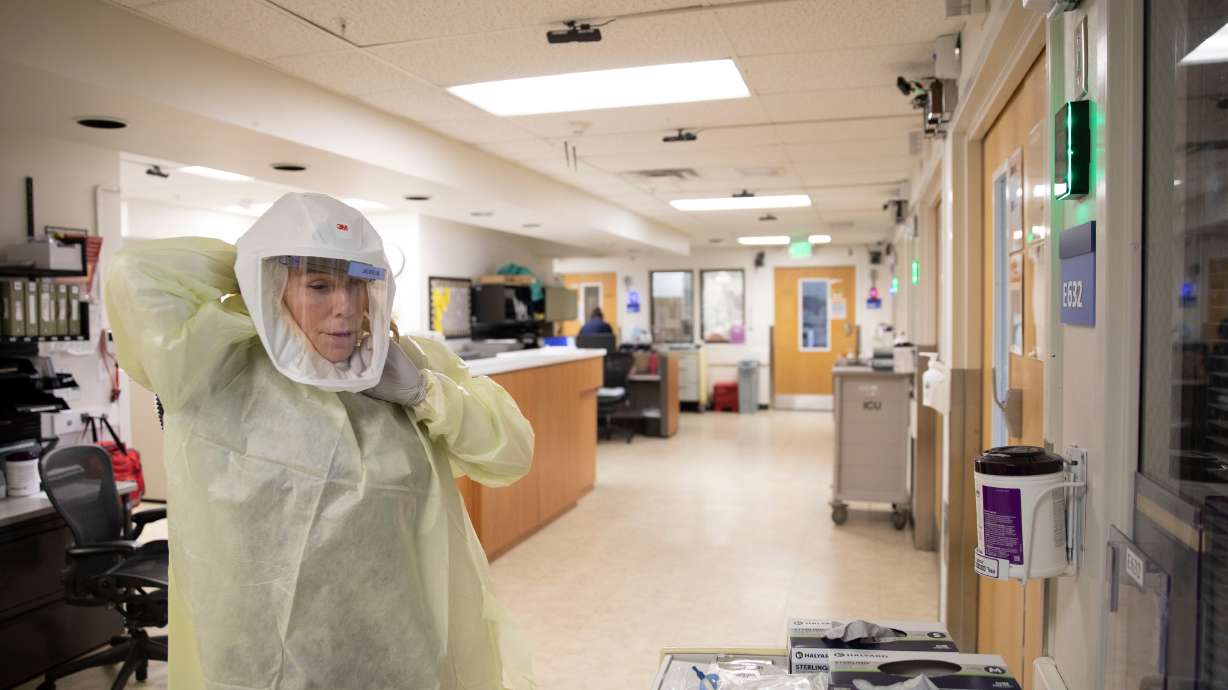Estimated read time: 4-5 minutes
This archived news story is available only for your personal, non-commercial use. Information in the story may be outdated or superseded by additional information. Reading or replaying the story in its archived form does not constitute a republication of the story.
SALT LAKE CITY — Utah health workers have yet to experience a reprieve after nearly two years of close to maximum capacity at hospitals, but COVID-19 numbers are slowly dropping, which means hospitalizations will likely follow suit.
"We are coming up on two years of doing this and it has been very fatiguing for a lot of people," Dr. Kencee Graves, associate chief medical officer for inpatient care with University of Utah Health, said Tuesday. There has been, however, a 46% decrease in COVID-19-related hospitalizations in Utah since Jan. 27, according to U. Health data presented during an update from physicians Tuesday.
There are 415 people currently hospitalized in the state with the still highly contagious disease, according to the Utah Department of Health's Tuesday report.
The agency announced another 2,068 new COVID-19 cases and 13 deaths on Tuesday, bringing the total number of confirmed infections in the state to 920,290. Although, 43 cases were removed from the overall count on Tuesday after quality analysis, the health department said in its report.
Of the new cases, 848 cases were confirmed on Friday, 566 on Saturday, 379 on Sunday, and 318 on the Monday holiday. Also among the weekend tally are 249 cases of COVID-19 confirmed among school-aged children in Utah.
The rolling, seven-day average number of people testing positive is now 21.2%, still declining from the peak of the omicron surge in January. The health department reports more than 9.1 million tests have been administered in the state since the COVID-19 outbreak began in early 2020.
About 32,510 tests and 11,323 doses of vaccine were administered across Utah since Friday. In all, the state has given out close to 5 million doses of COVID-19 vaccine. There is an estimated 1.97 million people in Utah who are fully vaccinated, with fewer than 900,000 having received a booster dose, according to the health department.
"Most of us recognize now that COVID-19 is not going to go away, that we're going to have to find a way to live with it," Graves said Tuesday.
Hospital staff have witnessed seemingly endless direct impacts of the coronavirus pandemic, with thousands of people having been admitted and died because of complications resulting from COVID-19 infection; but they've also seen a lot of indirect impacts as people have delayed care for other conditions.
As Utah and other places start to peel back some of the public protections that have been in place, Graves said it becomes an issue of people assessing their individual risk. And unfortunately, anyone who is not vaccinated or has underlying, immunocompromising conditions or is of advanced age, is still at a higher risk.
"We are currently living in a different world. ... Things are different now," she said, adding that proven treatments and prevention methods are now available to help protect the majority of the community. And more people and organizations are "talking about things like mental health now. We weren't doing that in 2020," Graves said.
Stephen Goldstein, a researcher with the U. School of Medicine, said there is still risk of potential new variants in the future and masks and social distancing are still "viable options to protect ourselves."
"It comes down to personal risk calculations," he said, adding that he hopes the risk of infection continues to wane with the decreasing numbers of cases and hospitalizations that will follow.
One thing is for certain, and the local data also shows it: having a booster vaccine mattered in the latest surge of the omicron variant of SARS-CoV-2.
"As we come down off a surge curve, there is still as much COVID in our community as there was in our fall 2021 surge," Graves said. "It's still out there. It's still a risk."
The likelihood of contracting it, however, she said, depends on individual risk and local transmission levels.
"Vaccination is the key here," Goldstein said, adding that booster doses of COVID-19 vaccine definitely increased protection during the latest wave of infection.
"The best way to stay ahead of another variant is to vaccinate the largest fraction of the population as possible," he said.
Viruses are constantly evolving and Goldstein said he expects more variants of this coronavirus to come. But, as more people are vaccinated and receive booster doses of the vaccine, he said, "the impact of those variants is going to be limited."
"The more of us that are fully vaccinated and boosted, the better the community does as a whole," Graves said.
Utah health officials on Friday announced intentions to leave testing for and treating the virus to health care systems in the state, as it backs away to a "steady state" of monitoring and assessing the prevalence of COVID-19 and other diseases, at the ready to intervene or provide support whenever necessary.
The 13 new COVID-19 deaths reported Tuesday include:
- A Box Elder County man, over age 85, who was a long-term care facility resident when he died
- A Carbon County man, 65-84, long-term care facility resident
- A Salt Lake County man, over 85, not hospitalized
- Four Salt Lake County men, 65-84, all hospitalized
- A Salt Lake County woman, over 85, not hospitalized
- A Salt Lake County man, 25-44, hospitalized
- A Sanpete County man, 45-64, hospitalized
- A Uintah County man, over 85, not hospitalized
- A Washington County man, 25-44, hospitalized
- A Weber County man, 45-64, not hospitalized








